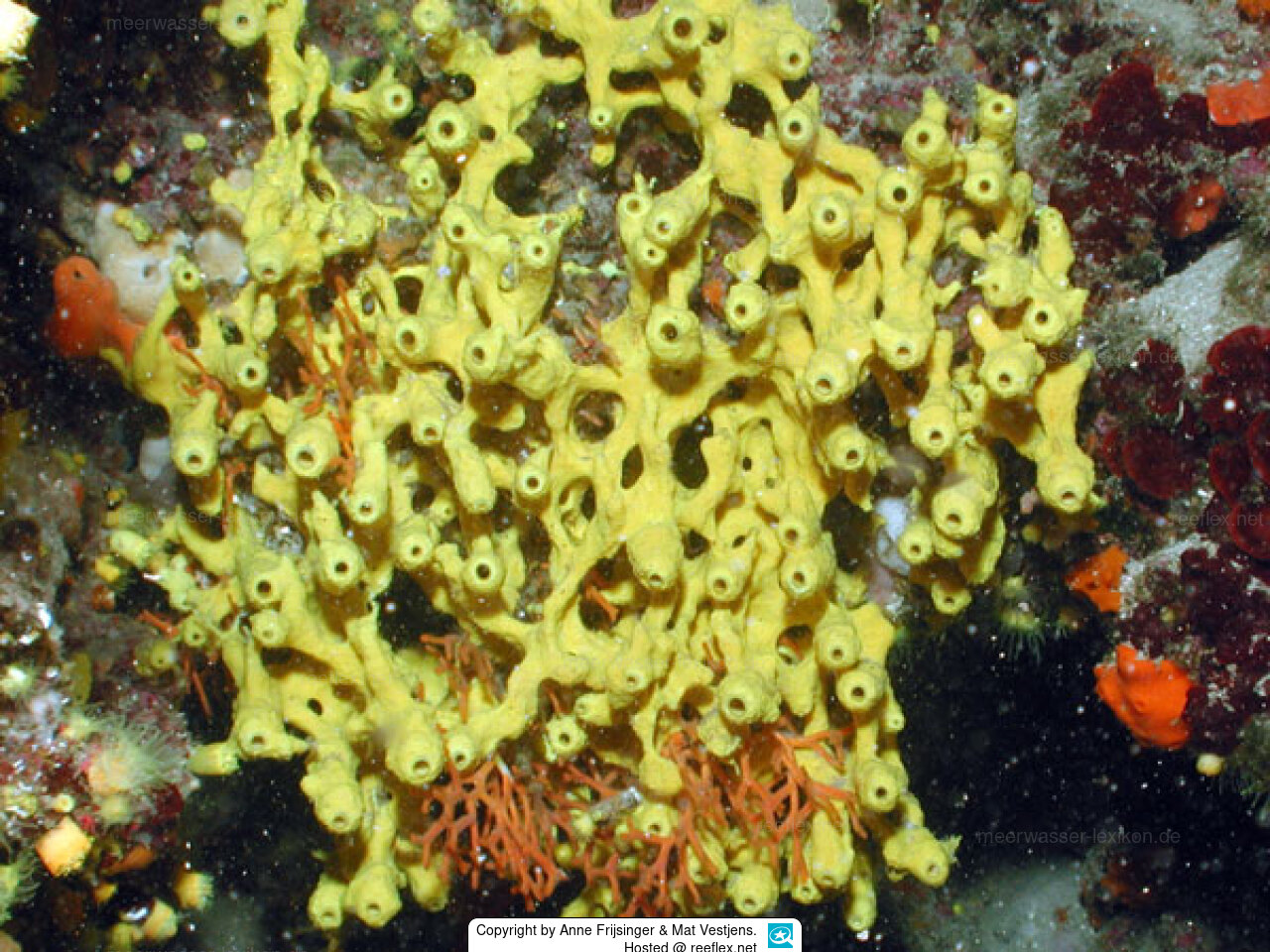Info
Aplysina cavernicola (Vacelet, 1959)
The type locality for the description of Aplysina cavernicola is the western Mediterranean Sea.
Aplysina cavernicola is a species of sponge belonging to the family Aplysinidae. It is native to the Mediterranean Sea, where it grows in caves and under overhangs.[2]
Description
Description: Body shape consistently finger-like (1-2 cm in diameter and 5-10 cm in height); each finger bears an osculum (1-3 mm) in the center of a distinct apical depression. Fingers regularly arranged on a basal crust plate with a diameter of over 50 cm. Thin outgrowths extremely rare. Color yellow, slightly paler than that of Aplysina aerophoba. Color changes after death to medium violet in preserved specimens and never reaches very dark or black shades.
Habitat: Caves, coral communities, rocky/detrital bottom. Depth range: 1-110 m.
Aplysina cavernicola forms clumps that can reach up to 30 cm in diameter. The sponge has a base that adheres to a rock or other hard surface, from which a number of finger-like projections up to 6 cm long and 2 cm in diameter protrude. The surface is sparsely covered with small conical projections caused by the tips of horn fibers embedded in the tissue. There are no spicules; structural support is provided by a network of spongin fibers. Water is absorbed through pores at the base of the sponge and expelled from the osculi, which are located in slight depressions at the tips of the projections. The body color is yellowish.
Aplysina cavernicola is a hermaphrodite; ciliated larvae known as parenchymellae are released into the water, soon settle in a suitable location, and undergo metamorphosis into young sponges.
Aplysina cavernicola accumulates brominated isoxazoline alkaloids in its tissue in concentrations of up to 10% of its dry body weight. Certain metabolic derivatives of these isoxazolines, such as dienone and aeroplysinin, are not inedible to fish but may have antimicrobial properties that protect the sponge from bacterial pathogens.
Aplysina cavernicola is host to the ectoparasitic copepod Entomopsyllus adriae.
Synonym: Verongia cavernicola Vacelet, 1959
The type locality for the description of Aplysina cavernicola is the western Mediterranean Sea.
Aplysina cavernicola is a species of sponge belonging to the family Aplysinidae. It is native to the Mediterranean Sea, where it grows in caves and under overhangs.[2]
Description
Description: Body shape consistently finger-like (1-2 cm in diameter and 5-10 cm in height); each finger bears an osculum (1-3 mm) in the center of a distinct apical depression. Fingers regularly arranged on a basal crust plate with a diameter of over 50 cm. Thin outgrowths extremely rare. Color yellow, slightly paler than that of Aplysina aerophoba. Color changes after death to medium violet in preserved specimens and never reaches very dark or black shades.
Habitat: Caves, coral communities, rocky/detrital bottom. Depth range: 1-110 m.
Aplysina cavernicola forms clumps that can reach up to 30 cm in diameter. The sponge has a base that adheres to a rock or other hard surface, from which a number of finger-like projections up to 6 cm long and 2 cm in diameter protrude. The surface is sparsely covered with small conical projections caused by the tips of horn fibers embedded in the tissue. There are no spicules; structural support is provided by a network of spongin fibers. Water is absorbed through pores at the base of the sponge and expelled from the osculi, which are located in slight depressions at the tips of the projections. The body color is yellowish.
Aplysina cavernicola is a hermaphrodite; ciliated larvae known as parenchymellae are released into the water, soon settle in a suitable location, and undergo metamorphosis into young sponges.
Aplysina cavernicola accumulates brominated isoxazoline alkaloids in its tissue in concentrations of up to 10% of its dry body weight. Certain metabolic derivatives of these isoxazolines, such as dienone and aeroplysinin, are not inedible to fish but may have antimicrobial properties that protect the sponge from bacterial pathogens.
Aplysina cavernicola is host to the ectoparasitic copepod Entomopsyllus adriae.
Synonym: Verongia cavernicola Vacelet, 1959







 Anne Frijsinger & Mat Vestjens, Holland
Anne Frijsinger & Mat Vestjens, Holland







